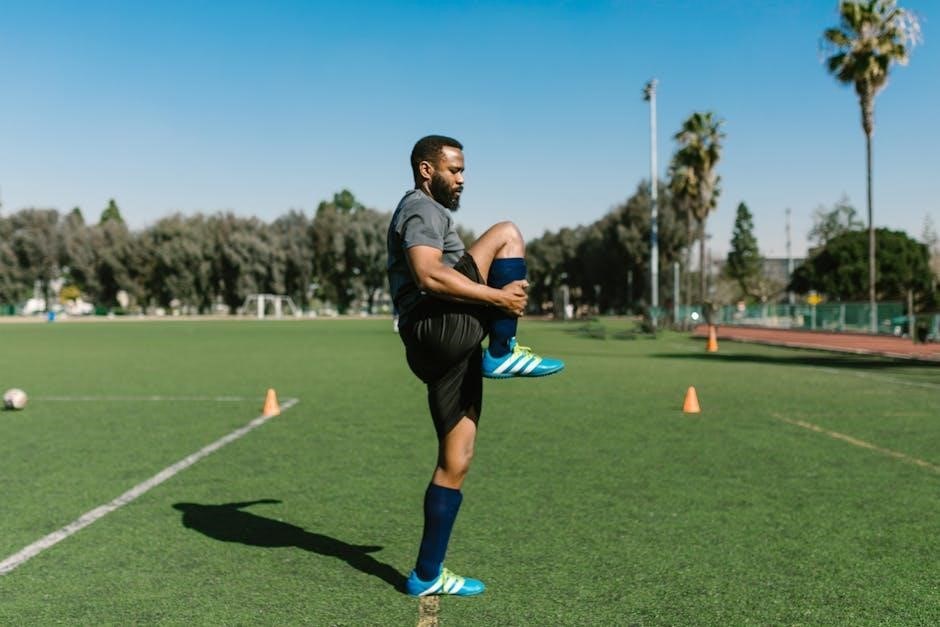Introducing the D1 Football Workout Program‚ a comprehensive training regimen designed to enhance strength‚ speed‚ agility‚ and endurance for elite athletes‚ ensuring peak physical performance and mental resilience.
Overview of D1 Football
D1 football represents the highest level of collegiate competition‚ demanding exceptional strength‚ speed‚ agility‚ and conditioning. Athletes must excel in both physical and mental resilience‚ as the sport requires intense preparation and strategic execution. The program is tailored to meet the rigorous demands of elite-level play‚ ensuring athletes are well-rounded and prepared for the challenges of top-tier competition.
Importance of a Structured Workout Program
A structured workout program is essential for D1 football athletes to ensure consistent improvement‚ reduce injury risks‚ and achieve peak performance. It provides a clear roadmap for enhancing strength‚ speed‚ and endurance while allowing for mental preparation and strategic execution. By following a tailored regimen‚ athletes can track progress‚ achieve specific goals‚ and maintain a competitive edge throughout the season.
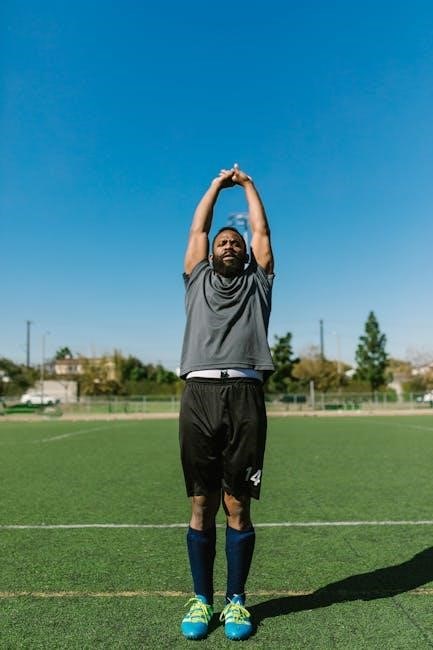
Structure of the Workout Program
The D1 Football Workout Program is organized into an annual training plan‚ divided into specific phases‚ ensuring a balanced approach to strength‚ speed‚ agility‚ and recovery.
Annual Training Plan
The annual training plan for D1 football is divided into distinct phases: off-season‚ pre-season‚ and in-season. Each phase focuses on specific goals‚ such as building strength‚ improving power‚ or enhancing endurance. The off-season emphasizes foundational strength and conditioning‚ while the pre-season shifts to sport-specific skills and intensity. The in-season phase maintains fitness while prioritizing recovery and performance. This structured approach ensures athletes peak at critical moments‚ balancing physical and mental demands with expert guidance from coaches.
Breaking Down the Program into Phases
The D1 football workout program is divided into three primary phases: off-season‚ pre-season‚ and in-season. The off-season focuses on building foundational strength and endurance‚ while the pre-season transitions to power and speed development. The in-season phase prioritizes maintenance and recovery‚ ensuring athletes remain competitive and injury-free. Each phase is tailored to specific performance goals‚ with progressive overload and periodization guiding the training process for optimal results throughout the year.
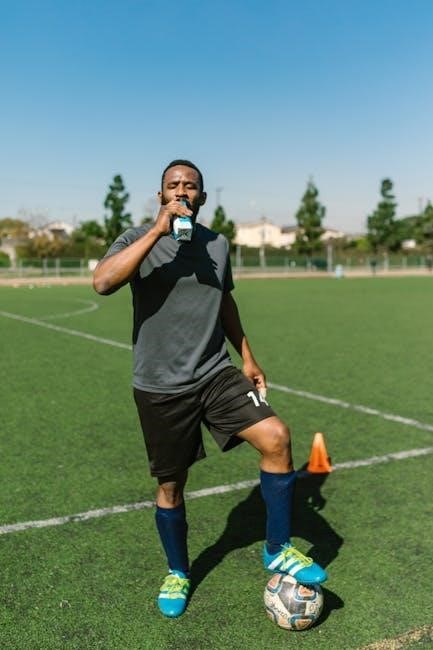
Strength Training Component
The strength training component focuses on building power and muscle mass through compound movements like squats‚ deadlifts‚ and bench presses‚ tailored to enhance football-specific performance and durability.
Key Exercises for Building Strength
The program emphasizes compound movements like squats‚ deadlifts‚ and bench presses to build overall strength. These exercises target multiple muscle groups‚ enhancing power and durability. Additionally‚ pull-ups‚ lunges‚ and leg presses are incorporated to improve functional strength specific to football movements‚ ensuring athletes can perform at peak levels during games and practices.
Creating a Strength Training Routine
A well-structured strength training routine is essential for D1 football athletes. The program is periodized into specific phases‚ focusing on hypertrophy‚ max strength‚ and power. Compound exercises like squats and deadlifts form the foundation‚ while accessory work targets muscle imbalances. The routine is tailored to individual needs‚ ensuring progressive overload and adaptation. This approach maximizes strength gains and prepares athletes for the demands of the season.
Role of a Strength Coach
The strength coach plays a pivotal role in designing and overseeing the workout program‚ ensuring athletes meet their performance goals. They assess individual needs‚ create personalized plans‚ and monitor progress. The coach also ensures proper technique to prevent injuries and maximizes gains. Their expertise in periodization and progressive overload is key to building strength and power‚ making them integral to the team’s success and competitive edge.

Speed and Agility Training
Speed and agility training enhances quickness‚ acceleration‚ and directional changes‚ essential for football. Tailored drills improve reaction time and overall performance on the field.
Importance of Speed in Football
Speed is a game-changer in football‚ enabling players to outperform opponents in sprints‚ accelerations‚ and quick directional changes. Faster athletes often dominate plays and create scoring opportunities.
Developing speed enhances reaction time and explosive power‚ making players more lethal in both offensive and defensive scenarios‚ ultimately elevating team performance and competitiveness.
Agility Drills for Quick Changes of Direction
Agility drills focus on enhancing quick directional changes‚ essential for evading opponents and accelerating rapidly. Cone drills‚ ladder exercises‚ and shuttle runs are key components‚ improving foot speed and balance. These exercises simulate game scenarios‚ helping players react swiftly and maintain control during sharp cuts or rapid decelerations. Incorporating these drills into training boosts on-field agility and explosiveness‚ giving athletes a competitive edge.
Incorporating Plyometrics
Plyometric exercises‚ such as box jumps‚ burpees‚ and depth jumps‚ are integral to the D1 Football Workout Program. These explosive movements enhance power‚ acceleration‚ and reaction speed‚ critical for football performance. Plyometrics improve muscle elasticity and neuromuscular coordination‚ allowing athletes to generate maximum force quickly. Proper technique and progression are emphasized to prevent injury and optimize results‚ making plyometrics a cornerstone of the program’s speed and agility training.
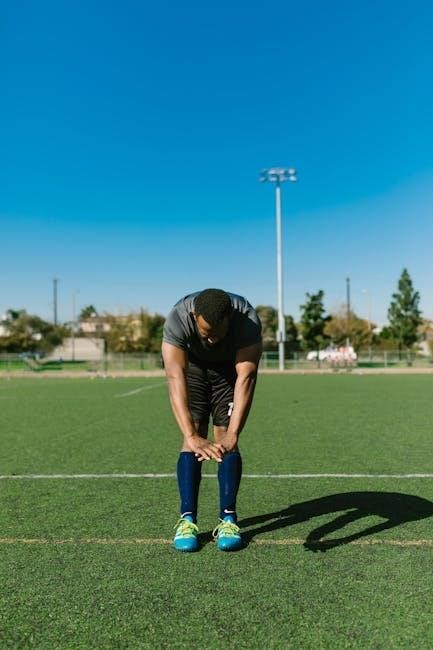
Conditioning and Endurance
The D1 Football Workout Program emphasizes aerobic exercises and High-Intensity Interval Training (HIIT) to build stamina and endurance‚ ensuring athletes can perform at peak levels throughout the season.
Aerobic Exercises for Football Players
Aerobic exercises are crucial for improving cardiovascular health and endurance‚ enabling football players to maintain high energy levels throughout games. Key exercises include jogging‚ cycling‚ and High-Intensity Interval Training (HIIT). These activities enhance stamina‚ boost metabolism‚ and promote fat burning. Incorporating sprints‚ agility drills‚ and distance running further strengthens the athlete’s ability to recover quickly and perform consistently. A well-structured aerobic routine is essential for peak football performance and season-long durability.
Building Endurance for the Season
Building endurance is critical for football players to sustain performance throughout the season; A combination of aerobic exercises‚ interval training‚ and strength-endurance workouts helps improve cardiovascular health and muscular stamina. Periodized training phases ensure gradual progression‚ preventing overtraining. Proper nutrition‚ hydration‚ and recovery strategies are essential to maximize endurance gains and maintain peak physical condition during the competitive season.
Designing Conditioning Workouts
Conditioning workouts are tailored to enhance football-specific endurance and stamina. They incorporate aerobic exercises‚ interval training‚ and strength-endurance drills. Workouts are periodized to align with the season‚ ensuring progressive overload and adaptability. Emphasis is placed on functional movements that mimic game scenarios‚ promoting both physical and mental toughness. Proper recovery and nutrition are integrated to optimize performance and prevent fatigue during intense training phases.
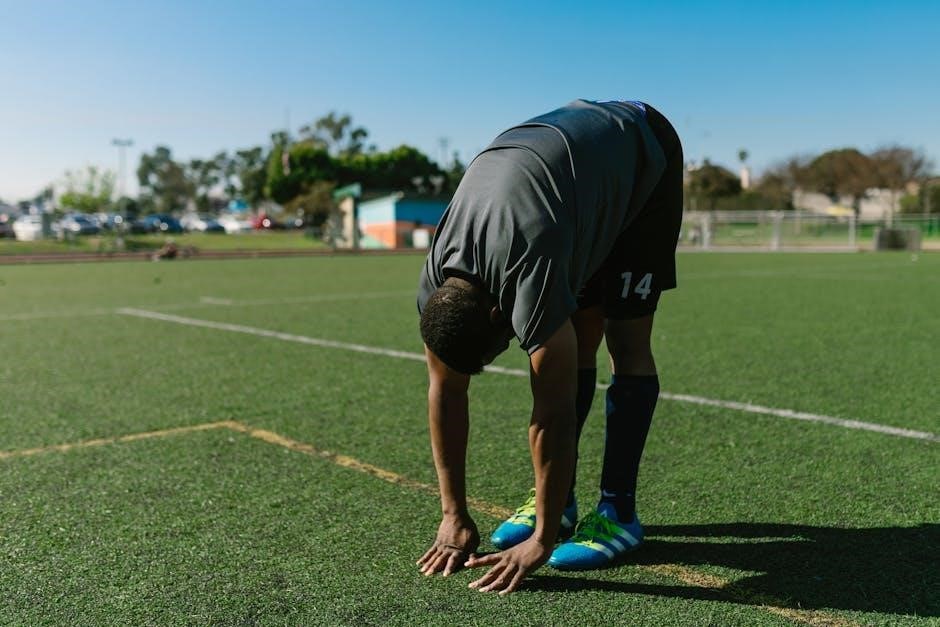
Flexibility and Mobility
Flexibility and mobility are crucial for football athletes‚ enhancing range of motion‚ reducing injury risk‚ and improving overall performance. Regular stretching and dynamic exercises ensure optimal movement efficiency and durability.
Stretching Routines for Football Athletes
Effective stretching routines for football athletes focus on dynamic and static exercises targeting major muscle groups like hamstrings‚ quads‚ and hip flexors. Dynamic stretches‚ such as leg swings and high knees‚ prepare muscles for activity‚ while static stretches improve flexibility. Incorporating yoga and Pilates can enhance range of motion‚ reduce stiffness‚ and prevent injuries‚ ensuring optimal performance on the field.
Improving Mobility for Better Performance
Enhancing mobility is crucial for football athletes to optimize performance and reduce injury risk. Incorporating dynamic stretches‚ yoga‚ and functional exercises improves joint flexibility and range of motion. Regular mobility work‚ such as leg swings and hip circles‚ helps maintain fluid movement‚ enabling athletes to perform at higher levels with better coordination and overall athleticism on the field.
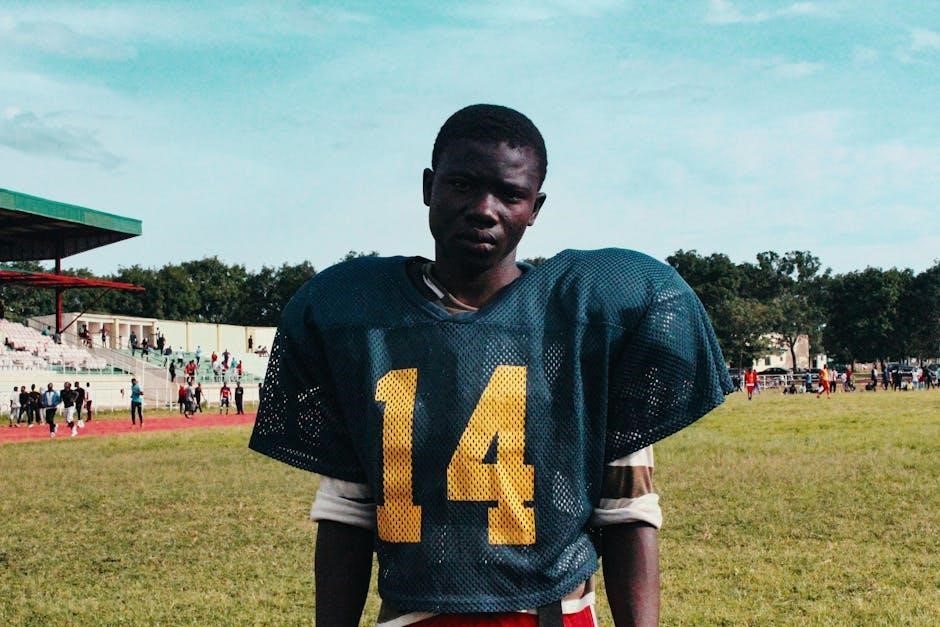
Nutrition and Recovery
Nutrition and recovery are vital for optimal performance. Proper hydration‚ balanced diets‚ and post-workout recovery strategies ensure athletes replenish energy and support muscle repair for peak conditioning.
Dietary Recommendations for Athletes
A balanced diet is crucial for D1 football athletes‚ focusing on lean proteins‚ complex carbs‚ and healthy fats to fuel performance. Proper hydration and timing of meals around workouts are emphasized to optimize energy levels and recovery. Supplements like protein shakes can support muscle repair‚ while avoiding processed foods helps maintain peak physical condition and overall health throughout the training season.
Role of Hydration in Performance
Proper hydration is essential for D1 football athletes‚ as it directly impacts physical and mental performance. Even mild dehydration can reduce strength‚ speed‚ and focus‚ increasing injury risk. Staying hydrated helps regulate body temperature‚ maintain energy levels‚ and support recovery. Athletes are encouraged to drink 8-10 glasses of water daily‚ adjusting for sweat loss during intense workouts to ensure optimal hydration and peak performance throughout the season.
Injury Prevention
Injury prevention is crucial in D1 football‚ focusing on proper warm-ups‚ strength training‚ and hydration to minimize risks and ensure long-term athlete health and performance.
Common Injuries in Football
Football athletes often suffer from hamstring strains‚ knee ligament tears‚ shoulder injuries‚ and concussions due to high-impact collisions and sudden movements. Ankle sprains and muscle pulls are also prevalent‚ stemming from quick directional changes and overuse. Proper warm-ups‚ strength training‚ and hydration are essential to mitigate these risks and protect athletes throughout the season.
Strategies to Prevent Injuries
Effective injury prevention involves dynamic warm-ups‚ strength training‚ and proper hydration. Incorporating flexibility exercises‚ such as stretching‚ and using recovery techniques like foam rolling or ice baths can reduce muscle strain. Personalized training plans tailored to an athlete’s needs help avoid overuse injuries‚ while education on proper movement mechanics ensures safer execution of drills and plays.
Recovery Techniques
Recovery is crucial for maintaining performance and preventing overtraining. Techniques include foam rolling to reduce muscle tension‚ ice baths to minimize inflammation‚ and stretching to enhance flexibility. Active recovery‚ such as light cardio‚ promotes blood flow without excessive strain. Adequate rest and sleep are also vital‚ allowing the body to heal and adapt. These methods ensure athletes return to training stronger and more resilient‚ optimizing overall performance and longevity in the sport.

Mental Preparation
Mental preparation is essential for building resilience and focus. Techniques like visualization and mindfulness help athletes stay composed under pressure‚ enhancing decision-making and overall performance on the field.
Mental Toughness Training
Mental toughness training is crucial for D1 football athletes to build resilience and focus. It involves techniques like goal setting‚ positive self-talk‚ and stress management to enhance performance under pressure. These methods help athletes maintain composure during critical moments‚ fostering confidence and consistency. Regular mental drills prepare players to overcome challenges‚ making them mentally formidable competitors on the field.
Visualization Techniques
Visualization techniques are powerful tools used by D1 football athletes to mentally rehearse plays‚ strategies‚ and scenarios. By vividly imagining game situations‚ players enhance focus‚ build confidence‚ and improve decision-making. This practice reduces anxiety and prepares athletes for high-pressure moments‚ fostering mental clarity and precision. Regular visualization sessions can also strengthen teamwork and adaptability‚ ensuring players are mentally prepared for real-time challenges on the field.
Role of Sports Psychologists
Sports psychologists play a vital role in enhancing mental performance‚ aiding recovery‚ and fostering team cohesion. They implement strategies to improve focus‚ resilience‚ and decision-making under pressure‚ which are essential for D1 football athletes. Their expertise ensures players maintain peak mental health and adapt effectively to challenges‚ contributing to overall success on and off the field.

Tracking Progress
Regularly monitoring strength‚ speed‚ agility‚ and endurance ensures athletes stay on track. Data analysis and goal setting help maintain motivation and focus throughout the program.
Setting and Achieving Goals
Defining clear‚ measurable objectives is crucial for success. Athletes break goals into short-term and long-term phases‚ tracking progress through performance metrics and regular assessments. Celebrating milestones boosts motivation‚ while adjusting strategies ensures continuous improvement. A structured plan with accountability helps maintain focus and drive‚ fostering a mindset of steady progression and excellence.
Using Data to Monitor Improvement
Tracking progress through data analytics is essential for optimizing performance. Metrics such as strength‚ speed‚ and endurance are regularly measured and analyzed. Advanced tools like wearable technology and performance software provide real-time insights‚ enabling coaches to identify areas for improvement. By leveraging data‚ athletes can adjust their training‚ ensuring consistent growth and achieving peak performance levels throughout the season.
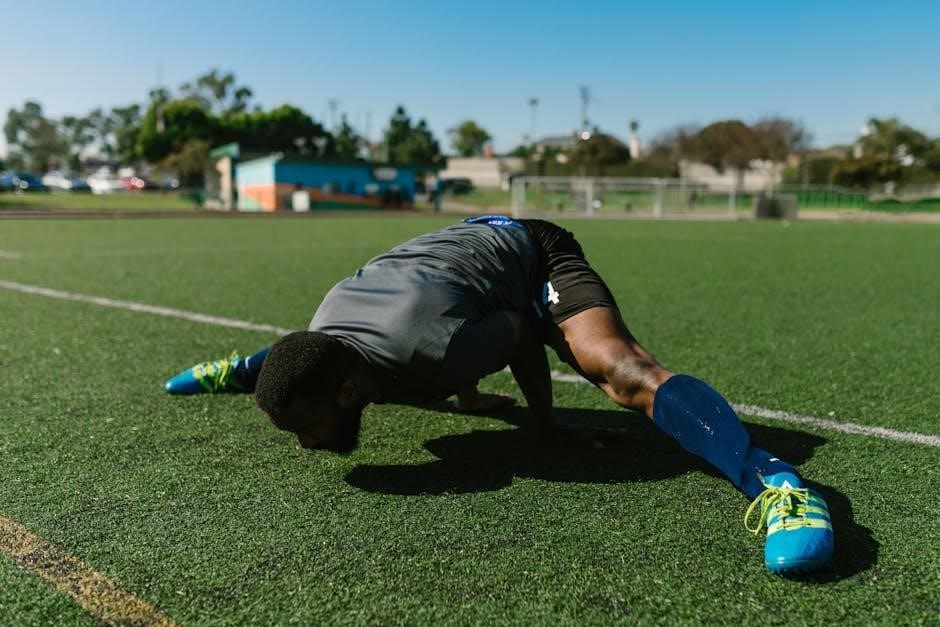
Benefits of the Program
The D1 Football Workout Program enhances performance‚ reduces injuries‚ and fosters team cohesion. It ensures athletes achieve peak physical and mental conditioning‚ driving long-term success on and off the field.
Enhanced Performance
The D1 Football Workout Program is designed to elevate athletes’ abilities through targeted training. By focusing on strength‚ speed‚ and agility‚ players achieve greater power and endurance. The structured regimen enhances explosiveness‚ allowing for faster sprints and sharper cuts on the field. Mental resilience is also boosted‚ enabling athletes to perform at their best under pressure. This comprehensive approach ensures players are prepared for the demands of elite competition‚ driving overall performance to new heights.
Injury Reduction
The D1 Football Workout Program incorporates injury reduction strategies through strength training and flexibility exercises. By focusing on balanced muscle development and proper form‚ athletes reduce the risk of common injuries. The program emphasizes controlled movements and recovery techniques‚ ensuring long-term durability. This approach not only enhances performance but also protects players from unnecessary wear and tear‚ keeping them healthy throughout the season.
Improved Team Cohesion
The D1 Football Workout Program fosters improved team cohesion by promoting unity and collaboration among athletes. Through shared goals and structured training‚ players develop trust and communication‚ enhancing overall team dynamics. The program’s emphasis on collective progress strengthens bonds‚ creating a supportive environment where athletes motivate and rely on each other‚ leading to a more unified and resilient team culture.
The D1 Football Workout Program successfully enhances athlete performance and resilience. Future advancements in training methods will continue to optimize results‚ ensuring sustained success.
Final Thoughts on the Program
The D1 Football Workout Program is a valuable resource for athletes seeking elite-level training. It balances strength‚ speed‚ agility‚ and endurance‚ fostering well-rounded development. By emphasizing structured routines and recovery‚ the program ensures sustained progress and resilience. Athletes who commit to this regimen can expect significant improvements in performance and durability. Consistency and dedication are key to unlocking its full potential and achieving long-term success in football.
The Future of D1 Football Workouts
The future of D1 football workouts lies in integrating advanced technology‚ sports science‚ and personalized training. Programs will likely incorporate wearable tech for real-time performance monitoring and AI-driven analytics to optimize routines. Emphasis will also grow on recovery techniques like cryotherapy and nutrition science. These innovations will help athletes achieve peak performance while minimizing injury risks‚ ensuring the D1 Football Workout Program remains at the forefront of athletic development.
